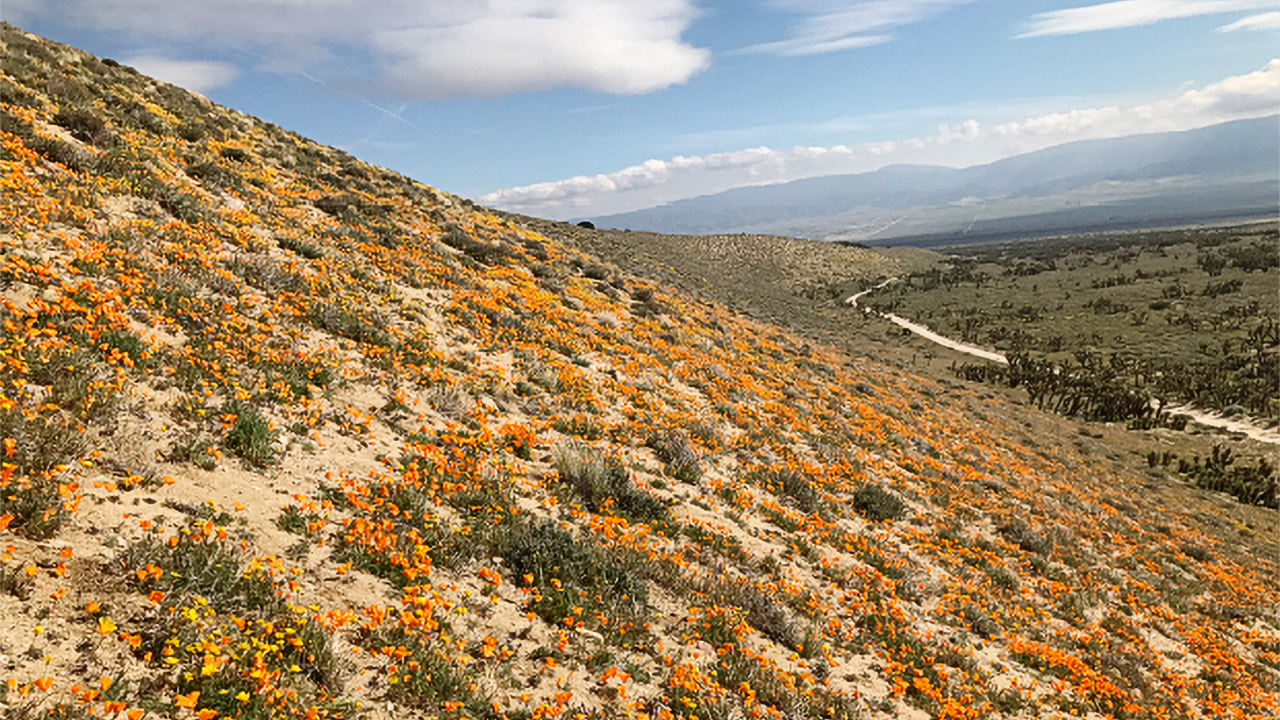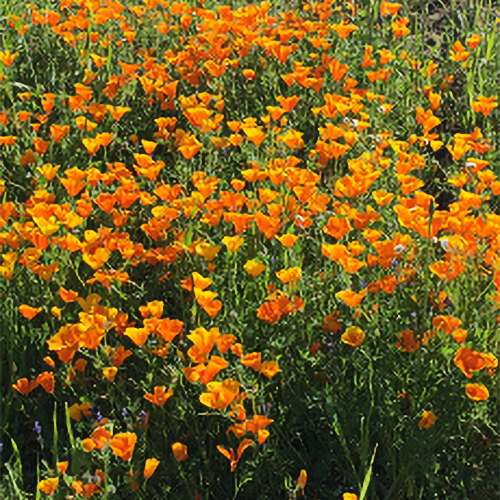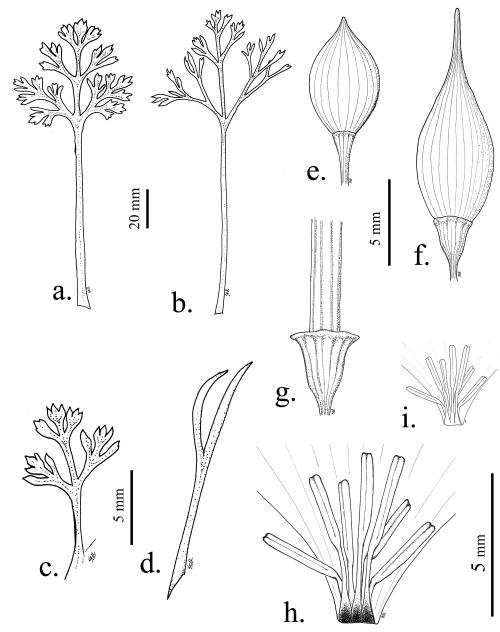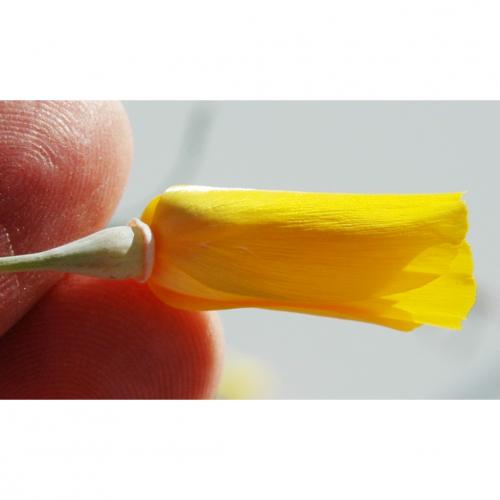
A Profusion of Poppy Confusion
| This has been adapted from an article originally published in Artemisia, the California Native Plant Society scientific journal. |
The California poppy (Eschscholzia californica) is a resilient and widespread species, native to the west coast of the United States, Baja California of Mexico, and the islands off both. This enigmatic species also flourishes in disturbed sites, along railways and roads, in locales as far-flung as Chile, South Africa, Australia, and the Mediterranean region. At present, systematists may recognize 18 taxa within the genus, with ranges that extend into Utah, New Mexico, and northern Mexico. These taxa exhibit a rich nomenclatural history that can help explain how and why plants get their names, and how the early descriptions influence—and at times muddle—our current taxonomic outlook.
In this article, I present a brief history of taxonomy in the genus, explore how it has changed over the years, and explain how that history influences species descriptions today. While botanists worked hard to organize species relationships in the past, we are still working to sort out the tree of life. Molecular work can help to clarify or even radically change our understanding of species relationships, and there have certainly been cases when, based on genetic analyses, we split or join species and give them new names. For the most part, however, molecular taxonomy has confirmed previously established relationships, with a few surprises at the higher levels of taxonomy.
In some cases, early categorizations have prejudiced botanists in favor of one set of distinguishing characteristics over other features. Sometimes these preconceived notions are warranted, but earlier descriptions can also prevent, or at least inhibit, our ability to find other characteristics that may be more helpful. Botanists have been overcoming such biases for decades. First, we can revisit old species descriptions and characteristics with a critical eye. This often happens with the writing of new floras and diagnostic treatments such as Flora of North America or The Jepson Manual. Coupled with these efforts are genetic analyses which, when compared with morphological data, can point to new morphological characteristics that help to describe species. While revisiting treatments may seem obvious, this practice can also present pitfalls. When I first undertook studies to examine the relationships within the genus Eschscholzia, for example, I struggled to break from some inherent biases I’d absorbed from the perspectives of previous experts.

The iconic California poppy
(Eschscholzia californica).

Eschscholzia caespitosa on
Zim Zim Falls Trail in Napa County.

Eschscholzia californica at Tejon Ranch in spring of 2016.
Poppies From the Past
On a voyage along the west coast of North America in 1816, Adelbert von Chamisso collected and described the type species for California poppy in the hills of the Presidio in San Francisco Bay. Chamisso’s close friend Johann Eschscholtz was on the journey and inspired the plant’s name. The California poppy became the official state flower in 1903 and has always played a role in the iconography of the state. Many of the most famous botanists of the early 20th century collected and named other members of the Eschscholzia genus and sent them to the most famous botanical institutions in the world.
Over time, this iconic wildflower’s names have also proliferated: Of the 187 named taxa historically recognized within the genus Eschscholzia, more than 90 are now recognized as synonyms for the California poppy (Still 2011). While a handful of species were trickling in through the late 1800s, the naming of new poppy taxa took a leap forward in 1905, with the publication of Edward Lee Greene’s “A Revision of Eschscholtzia” (Greene 1905). With this publication, Greene recognized 112 Eschscholzia taxa and did not hesitate to criticize other botanists who did not see the subtle differences he used to distinguish them: “As to the leaves of Eschscholtzia [sic], the phytoptically blind will say they are all alike,” he wrote. In retrospect, however, there was little basis for many of his distinctions, particularly as he regularly described new taxa based on only one specimen sent to him by another collector.
While Greene certainly had an eye for subtle differences among lineages, the 112 taxa he described led to a century of taxonomic confusion. In the early 20th century, other botanists also joined in the merriment of naming new poppy species, often without following consistent standards. German botanist Friedrich Fedde added 12, bringing the total number of Eschscholzia described to 126 by 1906 (Fedde 1906 a, b, c, d).
Greene and those who followed in his footsteps described more new taxa. Later botanists demoted them to subspecies or varieties of poppy species that had already been published, mainly E. californica and E. caespitosa. Occasionally, they designated a taxon that had already been described as a new combination of previously described species.
According to the traditional rules of botanical nomenclature, new taxa must be described in a publication and distributed to the general public or scientific institutions with accessible libraries or, more recently, made publicly available online. A new taxon should not use the name of an already validated taxon, and its description should identify the traits that distinguish the new taxon from those previously described. Anyone can name a new species if they follow these rules, but whether others agree that the new species should be recognized is another matter. If two taxa are described, but another botanist believes that the two are not different, then the more recently described taxon is treated as a synonym of the other. In the case of Eschscholzia, modern botanists consider many of the taxa that had previously been described as synonyms of E. californica. This process, known as synonymization, is how the nearly 190 Eschscholzia names were reduced to only one dozen. While many of Greene’s species are now synonymized, however, many of his taxonomic distinctions stand to this day.
Poppies certainly vary morphologically, and the profusion of described species helps illustrate how past taxonomic circumscription can lead to a great deal of contemporary confusion. The addition of each set of new names and descriptions added more characters for future botanists to consider, even though some are not relevant to heritable traits passed along the lineage.
There is no question that Greene had an eye for the different and unique. And while it cannot be argued that most of the names he published were valid, and that they followed the code for describing new species, many of the taxa he described should not have been described as different. In essence, Greene described new taxa on definable differences in specimens, but these differences could often be explained by morphological plasticity due to ecological site variation and the weather and not on genetic differences among species. The morphological characters of plants in a population can vary due to differences between dry and wet seasons, the amount of sunlight, the temperature, or the geologic substrate. It is common to have progeny from the same mother poppy that look decidedly different depending on whether they were collected in late winter or early summer. In the end, Greene’s eye for subtle differences helped to define our flora, but he also missed some of the local variation that might have been evident with more thorough study.
Jepson's Intervention
In 1922, Willis Lynn Jepson produced the first edition of A Flora of California, and with it brought a little order to the proliferation of poppies. “It should be emphasized that the amount of variation in Eschscholtzia californica is not by any means as great as would naturally be supposed from the large number of specific segregates which have been published,” he wrote. In the new flora, Jepson consolidated most of the previously described taxa into Eschscholzia californica, reducing the total taxa in the genus from roughly 120 to 12. This bold step refuted the expansive work of Jepson’s mentor, E.L. Greene. Greene had died in 1915 and was living on the other side of the country for several years even before his death. Perhaps this is why Jepson felt freer to be critical of his mentor and to more objectively evaluate diversity in the genus. Regardless, this consolidation helped to reshape the way that we now consider morphologic and taxonomic variability within the genus.
Where We Are Now
In the 99 years since Jepson’s revision, the number of described taxa in Eschscholzia has remained fairly steady. Once the traits that described the species were explained by Jepson himself, there has been relatively little taxonomic activity. Currently, botanists use 187 names and 160 type specimens to describe Eschscholzia (Still 2011; unpublished data). Of these names, 94 are considered synonyms for E. californica, 9 are synonyms for E. mexicana, and 20 are synonyms for E. caespitosa (Still 2011 and unpublished data).
While Jepson was correct that Eschscholzia is not as diverse as had been described by Greene, likely taxa could be resurrected from this long list of previously published names. More recent methods of molecular genetic analyses should prove useful at deciphering real species out of the variable poppy melange. To date, published molecular genetic research on variation within E. californica has been sparse.
The Likelihood of Cryptic Species

Several studies during the past half century have shown that more differences may exist within some species of Eschscholzia, particularly the California poppy, than currently recognized. But clear, conclusive evidence has proven difficult to acquire.
Much of the work attempting to tease apart the differences in the California poppy over the past half-century has been inconclusive. In the 1960s, for example, Stanton Cook conducted population studies on the California poppy and discovered some incompatibility between populations (Cook 1962) that could lead to eventual speciation. Although Cook found too much variation within and between populations to show any definitive differences in their morphology, he was using characters established a century prior, not the tools of molecular biology.
In the 1970s, Curtis Clark’s hybridization studies within and between populations of E. californica and E. mexicana (Clark 1978; Clark and Jernstedt 1978) provided some insight into these two closely related taxa and showed that these allopatric species could hybridize. This was, in part, why Clark placed E. mexicana as a subspecies of E. californica despite some small but consistent differences in morphology. Clark also helped to clarify relationships between the desert taxa, especially those related to E. minutiflora, the small-flowered poppy (Clark and Faull 1991). With this work Clark named a new diploid taxon and placed it with tetraploid E. covillei and hexaploid E. minutiflora, all as subspecies of E. minutiflora. While the individual subspecies have some consistent morphological differences, the range of the species did partially overlap, and Clark considered E. minutiflora to be a series of subspecies of different ploidy.
In the late 1990s to early 2000s, Erin Espeland helped to show that ecotypes from the sand hills in the Santa Cruz Mountains display leaves with distinct color patterns (e.g., purplish and white spots on leaves) and a different torus (receptacle rim) width when grown in common gardens (Espeland and Myatt 2001).
In another example of differences that may arise between populations, Leger and Rice (2003) showed that naturalized poppies in Chile grow more aggressively than the populations native to California when grown in a common garden.
Despite the apparent differences between populations, however, Sanger sequencing (Still and Potter 2013; unpublished work) did not show the sand hill ecotype to be genetically different from any other E. californica. Samples from populations used in the Leger and Rice paper were also included in the same studies by Still and did not show distinguishable differences between those populations and the native ones in California. This doesn’t mean there is no difference between the sand hills ecotype and the Central Valley ecotype or the plants that have become invasive in Chile, only that it was not apparent in molecular analyses used.
More recent work conducted by Nabeeh Hasan (2012) suggests that there may be additional distinct lineages of poppies than are currently recognized. While not unexpected, that hypothesis deserves further examination, to help narrow down which populations might be distinct. Hasan also speculates that the introduction of widely cultivated introduced genotypes near native populations could have contributed to loss of distinctive genetics. These introduced genotypes might genetically “swamp” native, distinct populations, which occurs when the genes of a genotype begin to reduce or replace unique genes of a more localized or native population.

Eschscholzia androuxii from Joshua Tree National Park. The plant displays the diagnostic characters of short bud tips on drooping buds and cauline leaves dissected into many segments.

Eschscholzia papastillii from Joshua Tree National Park. Plant displays the diagnostic characters of expanded, almost-conic, receptacle and cauline leaves dissected into one to few segments.

Eschscholzia papastillii displaying the diagnostic character of expanded, almost-conic receptacle and an often-scarious rim.
The Past is the Future
Botanical history influences our current understanding of plant taxonomy, and thus our future decisions as well. Once botanists have identified the main traits that define a taxon, subsequent researchers may have a hard time looking at things differently. In Eschscholzia, all native species have yellow or orange flowers (or a combination thereof ), and the ternately compound (consisting of three leaflets) leaves are fairly similar among species. So it is the small differences that can be difficult to notice and interpret, especially when you factor in phenotypic plasticity.
A recent example of where small differences and past biases have caused confusion comes from the desert taxa of Eschscholzia. Differences between the taxa can seem apparent in species descriptions or existing dichotomous keys, but eventually any botanist will run into specimens that defy the key and have characteristics that confuse identification.
Distinguishing between E. parishii and the three subspecies of E. minutiflora, as described by Clark, has proved difficult because of overlap between morphological characteristics including basal leaves, buds, and flowers. These characters were not definitive, and even accomplished botanists had trouble with identification. When later researchers completed further sequencing of the four species mentioned above, it became obvious that there was some cryptic speciation within the genus. These molecularly distinct samples led to our identification of two additional morphological characteristics that botanists had not previously considered, including leaves on the stem, and a pigmentation called anthocyanin marking the base of the stamens. This is a great example of how molecular data can focus the botanist’s eye on the right characters.
This approach helped sort out a case of taxonomic confusion in Joshua Tree National Park, where poppies had been identified as E. californica due to having a flared receptacle rim, normal for that species, but based on the new characters, those plants have now been identified as a new species, E. papastillii.
Conclusion
What botanists did in the past influences what we do now. Had we started anew and examined all of the 11,478 Eschscholzia specimens in the Consortium of California Herbarium portal without the biases and taxonomic categories inherited from past researchers, we almost certainly would have arrived at different species descriptions than they did. Yet botanical knowledge is built on the past, and historical species descriptions largely define our current ideas about what morphological characters matter for definition.
While California poppies are iconic—the news coverage of the 2019 super bloom is a good example—it is not difficult to imagine that the species could be split into two or more species, subspecies, or varieties. Even popular or well-known plants are not exempt from taxonomic change. Other cryptic species could likely be described, especially with more complex molecular analyses helping identify morphological differences.
Help, or more likely change, is on the way. As with much of science, sometimes the pace of progress can feel slow. Botanists get pulled into other projects and areas of research which delays progress on other topics. This is certainly true with Eschscholzia. But there is momentum. Researchers in Germany aim to complete a whole-genome sequence of Eschscholzia californica, to help with their studies of the evolutionary development of dissected leaves. California also recently funded a large grant, the California Conservation Genomics Project (www.ccgproject.org), to examine the conservation of genomes across the state for 150 species of flora and fauna, including Eschscholzia. Thus, in a few years, we should have whole-genome sequences for roughly 150 individuals of E. californica from different populations and ecoregions of the state.
In combination with the work spearheaded by Jenn Yost from Cal Poly, San Luis Obispo to digitize our native flora (www.cch2.org and www.capturingcaliforniasflowers.org), we may have further insight into the evolution of morphological characters that help distinguish our plant taxa. Imaging our herbarium specimens will allow us to combine genomic and morphological studies with phenological studies. As an example, I would love to see how the weather patterns in the months leading up to a collection influence the phenological and morphological traits of the specimens from herbarium sheets. That analysis alone could tell us a lot about phenotypic diversity, and maybe even a little about how we describe our plants.
The efforts discussed above, along with other projects by researchers in the state, may not identify all differences between species, nor find all instances of cryptic speciation, but these efforts will definitely provide better resolution of the relationships within and between species. Our knowledge advances like the genes of the plants that we study—typically through slow, ongoing evolution.
Shannon M. Still is the Director of Science and Conservation at the UC Davis Arboretum and Public Garden.
